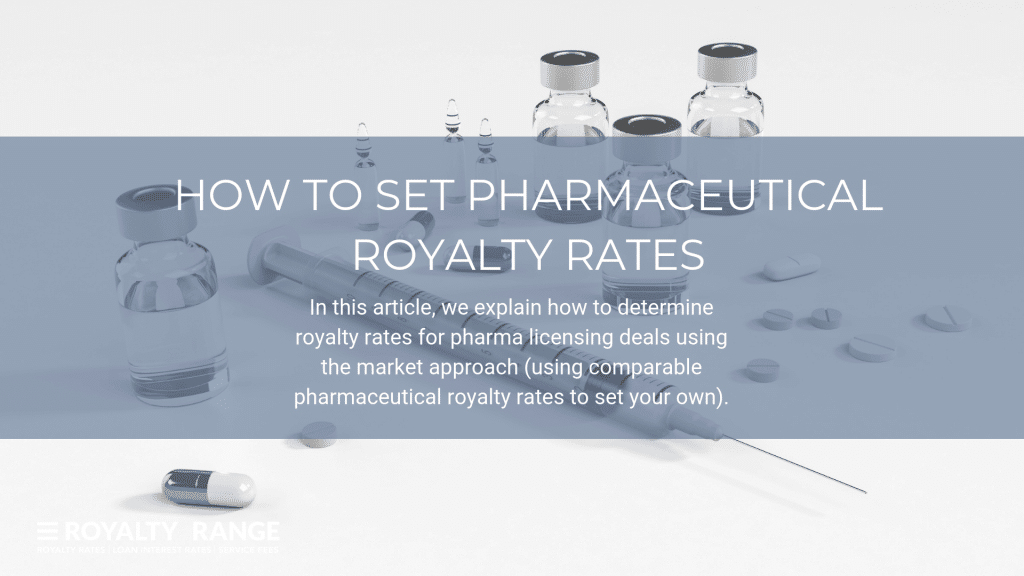How to set pharmaceutical royalty rates

Kris (Kestutis) Rudzika |
May 14, 2019

To set pharmaceutical royalty rates, you should look at comparable pharmaceutical royalties set in comparable pharma licensing deals. This will help you ensure they are fair, at arm’s length, justifiable and attractive to licensees. You can use the RoyaltyRange royalty rates database to find the recent comparable license agreements you need to help you set pharmaceutical royalties. To start your search, go to the bottom of this page, where you can download readymade pharma royalty rates reports and benchmarking studies or request a tailored royalty rates search.

In the pharmaceutical industry, companies often create drugs or therapies and license them to another company that then develops, manufactures and/or commercializes them.
If you are entering into a pharma licensing deal, you will need to set fair pharmaceutical royalty rates to ensure the licensor and licensee both benefit fairly from the licensed IP.
In this article, we explain how to determine royalty rates for pharma licensing deals using the market approach (using comparable pharmaceutical royalty rates to set your own).
How do pharmaceutical royalty rates work?
Usually, a royalty rate is set as a percentage of sales revenue generated by the licensed intellectual property. For example, say your organization has created vaccines for the prevention of chronic Hepatitis C virus infections. You have decided to license your patent and technology rights to a third party so that they can make, commercialize and sell the vaccines on your behalf. If you agree a royalty rate of 5% on net revenue, then you are entitled to 5% of the net revenue generated by the use of your IP.
The royalty rates you set can either be fixed or tiered. Fixed royalty rates stay the same for the duration of the license agreement, while tiered royalties are adjustable. In the pharmaceutical industry, tiered royalties are sometimes applied if a license agreement covers both developed and developing markets. If you are licensing a drug for malaria or HIV/AIDS, for example, then you may set a lower royalty rate for developing markets. You may also use tiered royalty rates to encourage more sales – e.g. you may set a royalty rate of 8% for the sale of up to 100,000 units, and then drop this to 6% for anything above that.
How to determine royalty rates for pharma licensing deals
There are a number of approaches you can take to identify a fair royalty percentage for your pharma licensing deal. Here, we focus on the market (or transactional) approach.

Under the market approach, you base your pharmaceutical royalty rates on those earned in comparable license agreements between independent parties. This enables you to see what royalties were set for comparable intellectual property in comparable circumstances.
The first step in the market approach is to find suitably comparable recent pharma license agreements. You can use the RoyaltyRange royalty rates database to find these.
Make sure the third-party license agreements you use are comparable
For the market approach to be reliable, the third-party license agreements you refer to need to be sufficiently comparable. Ideally, you’ll use royalty rates from comparable agreements for comparable intellectual property in the same market.
Here are just some of the comparability factors you should check for:
- Intellectual property type: Check for type of IP (trademark, patent, know-how, etc.) and phase of development (preclinical, approval, marketing, etc.).
- Market: The potential profitability of pharma intellectual property can vary from market to market due to different economic circumstances and competition.
- Exclusivity: Exclusive licenses often demand higher royalties.
- Duration: The duration of the license may influence the level of the royalty.

When you use the RoyaltyRange royalty rates database, we check the selected license agreements for comparability on your behalf. Our experts analyze each agreement against more than 50 comparability factors. These include intellectual property type, industry, geographical coverage, agreement date, exclusivity, useful life and development stage.
Phase of development and medical field
Pharmaceutical royalty rates vary depending on phase of development and medical field. A patent license agreement for a vaccine in the preclinical phase may have a different royalty rate to an agreement for a vaccine in the marketing phase. Likewise, some medical fields demand premium royalty rates while others tend to be lower. It is important to keep this in mind both when analyzing third-party license agreements and setting your royalty rates.
Recap of this article’s main points
A reliable way to set fair pharmaceutical royalty rates is to use the market approach. This involves basing your rates on comparable royalties earned in comparable license deals. You can search the RoyaltyRange database for the latest comparable pharma licensing deals. Keep in mind the phase of development and medical field, as these can affect royalty rates.
Use the RoyaltyRange royalty rates database today
You can find recent pharmaceutical royalty rates by using the RoyaltyRange database below. We offer three different search options: readymade royalty rates reports, readymade benchmarking studies and a tailored royalty rates search. You can find out more about each of these options by using the above links or getting in touch with us.
What pharmaceutical royalty rates can you find in the RoyaltyRange database?
Biotechnology royalty rates
Drugs and medical devices
- Syringes
- Ophthalmology
- Homeopathy
- Gynecology
- Dermatology
- Pneumology
- Gastroenterology
- Proctology
- Urology
Pharmaceuticals
- Active ingredients
- Antibodies and immunoglobulin
- Immunostimulants
- Leukemia treatment
- Medical and pharmaceutical products
- Nutraceuticals
- Wound healing
- Pharmaceutical preparations
Search the RoyaltyRange database for pharmaceutical royalty rates today: royaltyrange.com
Request One Search
We will perform the search and deliver the initial results within hours, at no cost.




